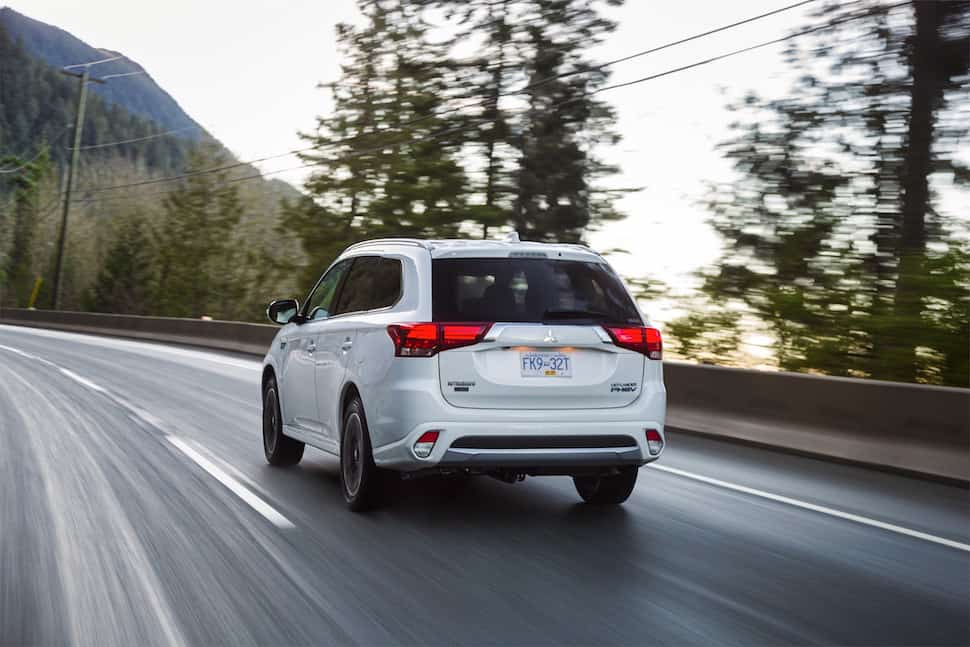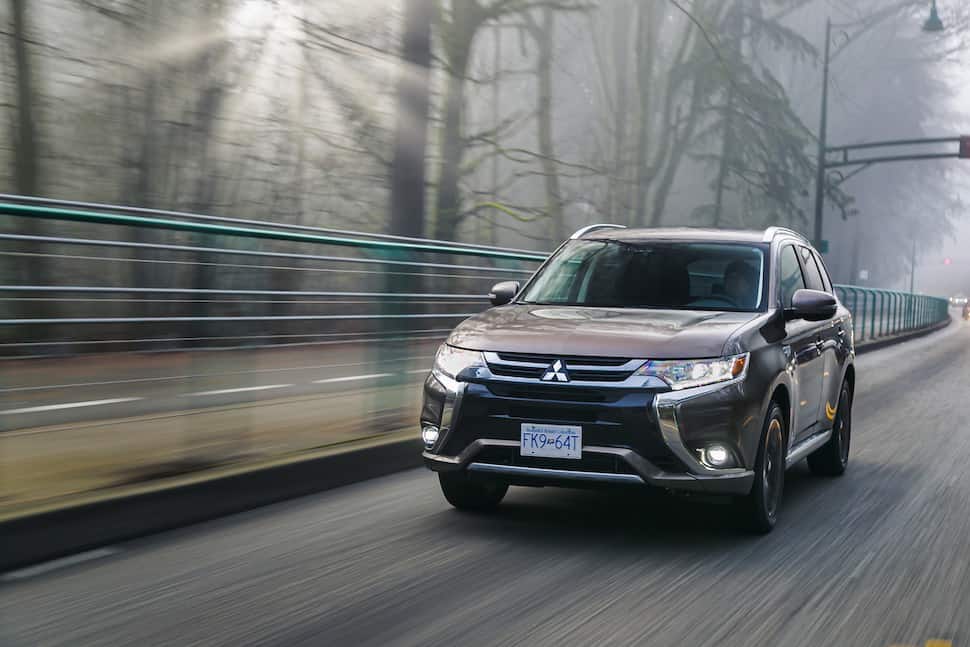Mitsubishi sold more than 5,052 Outlander PHEV models in 2018, which the company says is the first time a plug-in hybrid has surpassed 5,000 sales in Canada in one calendar year (5,270, to be exact). If that number surprises you, it should. And it shouldn’t. It should, if only because if any carmaker was going to do that, I’d not have guessed it would be one of the country’s smallest. It shouldn’t be because the Outlander PHEV is actually pretty darn good.
Related – Right on Time for an Upgrade: 2025 Mitsubishi Outlander First Drive
Outlander PHEV Cs ICE: What’s The Difference?

First, aside from the badging, clues that this is any different from the gas-powered Outlander are few: there’s the extra filling door on the passenger side for the charging port, the shifter is a joystick instead of a traditional PRNDL stick and the instrument panel has details on the powertrain the gas model doesn’t.
Interior

Dimensions
It’s the same vehicle in terms of passenger and cargo space, with the battery pack hidden beneath the floor and the electric motors under the hood and on the rear axle. The cargo floor may be an inch higher, but you don’t notice it.
| Specification | Measurement |
|---|---|
| Passenger Seating Capacity | 5 |
| Passenger Volume | 2,891 L / 102.1 cu. ft. |
| Passenger Volume with Sunroof | 2,860 L / 101.0 cu. ft. |
| Cargo Area (Behind Front Seats) | 2,208.7 L / 78.0 cu. ft. |
| Cargo Area (Behind Rear Seats) | 860.8 L / 30.4 cu. ft. |
Interior Features
There are a few things Mitsu could do better inside, and that’s integrating components better. It’s a minor thing, I’ll admit, but having the odd outlier button or knob or control that’s not anything like the others screams of parts-bin raiding. The touchscreen display for audio control is quite busy, and the crowded placement of control areas requires you to focus on the display when performing tasks. It does have an actual volume knob. A tuning knob would also be perfect.
Estimated Energy & Fuel Consumption

| Spec | SE S-AWC | SE S-AWC Touring | GT S-AWC |
|---|---|---|---|
| City (L/100KM) | 3.0 (9.4) | 3.0 (9.4) | 3.0 (9.4) |
| Highway (L/100KM) | 3.4 (9.0) | 3.4 (9.0) | 3.4 (9.0) |
For average daily use, it’s incredibly economical. My second chance to drive one was in Truro, N.S., where my son and I spent a week competing in the Canadian National Archery Championships. Our daily driving was about 30 kilometres a day, and the hotel featured a free CHaDeMo charging station: 25 minutes of charging and the battery was full.
Had this been in a home, a 240-volt charging station would have done the same in about 3.5 hours or 13 hours at 120 volts. When we didn’t leave Truro, we didn’t burn gas, or at least burned so little it didn’t move the fuel gauge at all. It’s that simple.
And when we did drive to Halifax or to Peggy’s Cove, we did so quite economically. The first 30 kilometres or so were entirely electric, and then we averaged about nine litres per 100 km once the gas motor kicked in. Even when I thought it was getting thirsty, having drained seven-eighths of a tank, the resulting fill-up was a surprise: only about $40.
Power and Handling

3 Drive Modes
Outlander PHEV operates in three different modes: electric, where it behaves as though it had only electric power; series, which is also known as range-extender mode, where the gas engine does nothing but power the generator to provide electricity; and parallel, in which the gas and electric motors share propulsion duty.
There are a few twists worth noting, as well. If you know you’re going to be on the highway for a while and want to run in EV mode when you get into a city, you can select “save” mode, which minimizes battery exhaustion. It’s perfect for highway driving, where the benefits of any hybrid evaporate very quickly, but it preserves hybrid functionality for when you reach another city, where hybrids shine. “Charge” mode will use the gas motor to charge the battery, either while parked or while driving. Again, it helps on the highway where you can restore some of the EV capability for when you get into a city.
| Specification | Outlander PHEV |
|---|---|
| Motor Type | Twin – AC Synchronous Permanent Magnetic Motor |
| Motor Power Output (HP) – Front | 80 hp |
| Motor Torque Output (LB.-FT.) – Front | 101 lb.-ft. |
| Motor Power Output (HP) – Rear | 80 hp |
| Motor Torque Output (LB.-FT.) – Rear | 144 lb.-ft. |
Engine & All-Wheel Drive
The PHEV also provides a variation on Mitsu’s Super-All-Wheel-Control system: in gas vehicles, this system operates with driveshafts and clutches to send torque to the four wheels in varying proportions. In the PHEV, the gas and main electric motor are connected to the front wheels only. An electric motor on the rear axle provides rear-wheel torque when needed, and a computer directs torque from side to side as needed.
You can engage 4WD Lock, which even in the PHEV, which has no mechanical link between front and rear axles, simulates locking the centre differential.
| Specification | Outlander PHEV |
|---|---|
| Drivetrain | S-AWC |
| Engine Type | 2.0 L MIVEC I-4 |
| Valve Train | DOHC 16-valve, Mitsubishi Innovative Valve-timing Electronic Control System (MIVEC) |
| Displacement (CC) | 1,998 cc |
| Horsepower @ RPM | 117 hp @ 4,500 rpm |
| Torque @ RPM (LB.-FT.) | 137 lb.-ft. @ 4,500 rpm |
| Air Intake System | Conventional |
| Engine Block | Aluminum |
| Fuel System | MPI |
| Emissions | TZEV |
| Recommended Fuel | Regular Unleaded |
| Engine Oil Type | 0W-20 |
| Engine Oil Capacity (L/QT.) | 4.3 L / 4.5 qt |
So, How Does it Drive?
First, forget everything you thought you knew about Outlander. Yes, the original model to use this body had atrocious handling, with what I’m guessing was severe rear sub-frame flexing that made hard cornering quite the collection of sphincter moments.
Those days are long gone: the Outlander now rides and handles as well as any mid-size SUV in its class. The seats are comfortable, the vision is excellent, and the interior design is quite well done.
Related – 2023 Mitsubishi Outlander PHEV First Drive Review
| Specification | Outlander PHEV |
|---|---|
| Steering Type | Electric Power, Rack-and-Pinion |
| Turning Circle – Curb to Curb (M/FT.) | 10.9 m / 35.6 ft. |
| Turns – Lock to Lock | 3.3 |
| Front Brake Type | Ventilated Disc |
| Front Brake Diameter (MM/IN.) | 294 mm / 11.6 in. |
| Rear Brake Type | Solid Disc |
| Rear Brake Diameter (MM/IN.) | 302 mm / 11.9 in. |
| Anti-Lock Braking System (ABS) | 4 Sensor, 4 Channel with EBD |
| Wheel Type | 18x7J Aluminum Alloy |
| Wheel Size (Optional) | 18 in. |
| Tire Size (Optional) | P225/55R18 |
| Suspension: Front | MacPherson Strut |
Takeaway
Does the Outlander PHEV save so much money in fuel you should choose it over, say, a Honda Fit or Mazda3? No. The economics just don’t work out. Where it does make sense is if you’re already shopping in the mid-size SUV market: many models with similar prices won’t come close to its fuel efficiency.
That it’s a plug-in, with 35 kilometres of EV range, means many Canadian drivers can do their daily driving on nothing but electricity. Mitsubishi states each 100 kilometres of EV driving takes 27.7 kilowatt hours of electricity for charging. In Manitoba, that works out to $2.36 per 100 kilometres, compared to $10 to $12 per 100 km with gasoline. Now do I have your attention?
2018 Outlander PHEV Key Specs
- Engine: 2.0-litre, 16-valve, four-cylinder,
- Electric motors: twin AC synchronous permanent magnet motors
- Power: (gas) 117 hp @ 4,500 r.p.m.; (electric) 80 hp (front); 80 hp (rear)
- Torque: (gas) 137 lb-ft. @ 4,500 r.p.m.; (electric) 101 lb-ft (front); 144 lb-ft (rear)
- Transmission: single-speed, drive-mode switchable reduction gear box (front); single-speed, fixed reduction gear box (rear)
- Brakes: four-wheel discs
- Steering: electric power rack-and-pinion
- Suspension: MacPherson strut with stabilizer bar (front); multi-link with stabilizer bar (rear)
- Fuel economy (l/100 km, city/highway/combined): 3.0/3.4/3.2 (equivalent (electric)); 9.4/9.0/9.2 (hybrid)
- Price (Canadian): $42,998 (base S AWC); $45,998 (base, SE S-AWC Touring); $49,998 (GT S-AWC)
Note: for the purposes of calculating electricity costs, ignored was the basic monthly charge, which everyone pays anyway.



